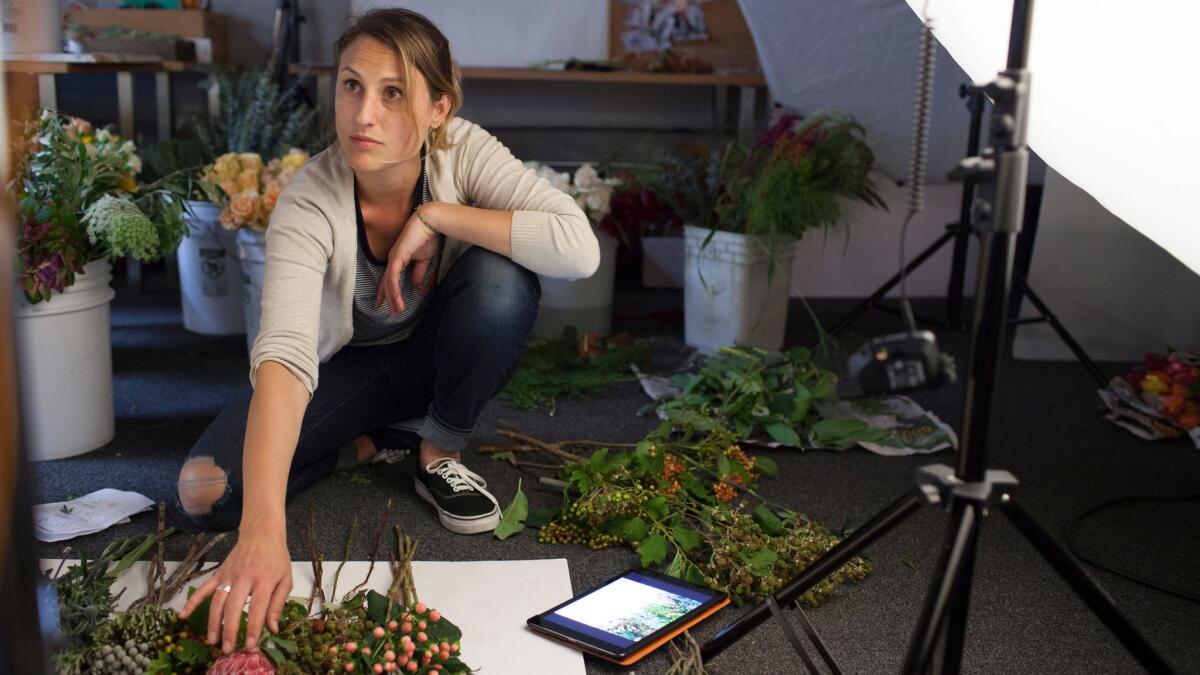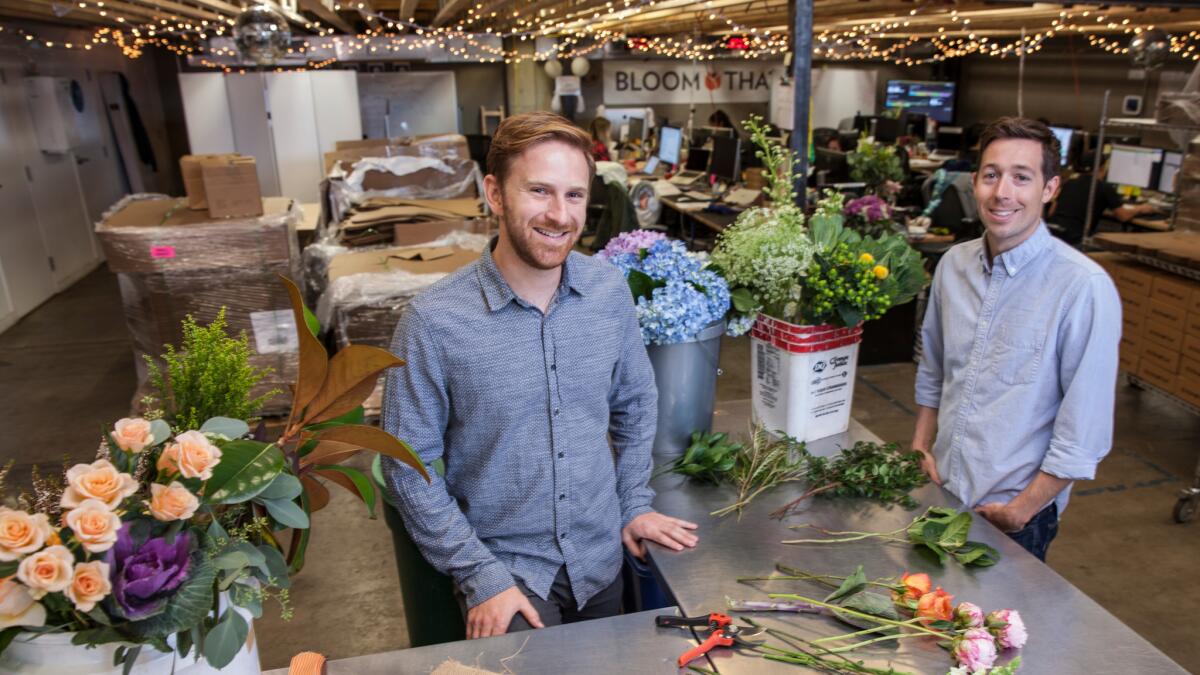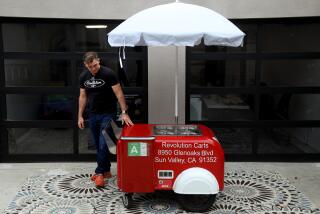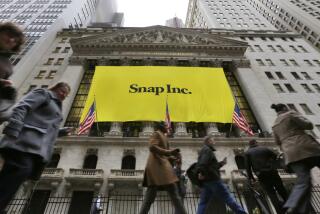On-demand business models have put some startups on life support

- Share via
Reporting from San Francisco — Last summer, flower delivery start-up BloomThat was in an enviable position.
The 2-year-old San Francisco company had raised more than $5 million in venture capital funding. It had earned a tech world pedigree after graduating from the prestigious incubator Y Combinator. And it had its roots firmly planted in the “on-demand economy” -- a business model popularized by Uber that was the hot new category in Silicon Valley.
But to live up to its promise of delivering bouquets within one hour in three markets, BloomThat was hemorrhaging cash. After launching in New York last summer, it was burning through more than $500,000 a month.
“It was not good; we probably had around four to five months of runway left,” said David Bladow, BloomThat’s co-founder and chief executive.
Faced with the prospect of going bust, Bladow and his cofounders asked themselves: Do customers really need their service at the press of a button?
It’s a question being asked at a number of startups that promise instant gratification. As the on-demand business model strains companies’ finances and the tech downturn makes investor money harder to come by, companies are realizing that what works for Uber may not work for them.
Some, like BloomThat, have changed course from a model that was, for a time, seen as the easiest way to land funding in Silicon Valley.
“Someone said, ‘grow, grow, grow,’ and someone else parroted it, then everyone else parroted it, and we fell victim to the macro trend,” Bladow said.
Last year alone, venture capital firms invested more than $17 billion across 214 companies that had the on-demand business model, up from $7.3 billion the previous year. These investments represented nearly 13% of all venture funding that year, according to data gathered by CB Insights.
Uber, the pioneer of the on-demand model, also continued to grow, giving the Valley reason to keep throwing money at on-demand businesses.
Uber reportedly seeks to raise up to $2 billion in the leveraged loan market »
But offering rides is different from selling flowers.
For Uber to offer on-demand service, all it needs is lots of drivers using their own cars to log onto the app and start driving. For BloomThat to deliver flowers in a one-hour window, it had to set up distribution centers stocked with fresh bouquets that were ready to be deployed at a moment’s notice. That takes real estate, supplies and staff -- before even getting into the logistics of one-hour delivery.
Zirx, a venture-funded San Francisco startup that offered on-demand valet parking, found its initial business model undermined by similar costs.
The company was paying a premium to lease parking spots in cities that have notoriously few parking spots. The more popular the company got, the more it cost to secure additional spots. Customers, however, weren’t willing to pay the premium.
“Most consumers have a price point in mind for a service,” said Sean Behr, chief executive of Zirx. “The consumer is unwilling to pay for the true nature of on-demand.”
The idea that we’re an on-demand company — that was part of the problem.
— Matt Schwab, BloomThat co-founder and president
And so the first signs of an on-demand exodus have started to show. Some, like Spoonrocket (on-demand meals), Homejoy (on-demand house cleaning), and Shuddle (Uber for kids), have gone out of business because they couldn’t raise enough money. Sidecar, an Uber competitor, sold its assets to General Motors last year. And Zirx has dropped the on-demand component of its business entirely.
“A company needs to look into their own business and ask themselves what they’re best at,” said Eurie Kim, a partner at venture capital firm Forerunner Ventures, which invested in BloomThat and supported the company’s move away from on-demand delivery. “When you do that, you realize there are probably two or three things your customer really loves about your business, and it’s not necessarily the delivery.”
For BloomThat, the company learned that customers thought on-demand delivery was nice, but it wasn’t a deal breaker. People didn’t mind ordering flowers and getting them in a later window, or even the next day. By extending the delivery window by an hour, the company was able to reduce its number of drivers and distribution centers and cut costs by 25%.

The company now offers on-demand delivery only in city centers, and nationwide next-day delivery. The latter accounts for 50% of its orders, and the company became profitable four months ago.
When Behr looked at Zirx’s model, he realized “it would be a very difficult product to make money.” So he, too, changed the company’s course. Earlier this year Zirx changed its business to offer a service where it moves vehicles for other companies, such as rental car services, mechanics, and car dealers. Behr expects Zirx to be profitable by the end of the year.
“The idea that we’re an on-demand company -- that was part of the problem,” said Matt Schwab, BloomThat’s co-founder and president. “We’re not an on-demand company. We’re a company that builds products that has on-demand delivery. It seems trivial, but flipping the thinking changed the focus of the company.”
There are some industries where on-demand delivery is critical, said Ooshma Garg, founder of Gobble, a dinner kit company that delivered on-demand meals back in 2012, before changing to a subscription model. But that only applies to two or three industries, not 100.
“We figured out that on-demand didn’t work for us within three months of trying it,” she said.
During its on-demand period, the quality of Gobble’s food and service suffered. Its target market, which was families, lived in the suburbs -- meaning it had to have delivery drivers stationed across the Bay Area with trunks full of food. Any meals that weren’t sold went to waste. It wasn’t profitable.
Gobble quickly changed direction to a subscription model. It is now 20 times larger and is no longer losing money.
It’s not just companies that are waking up to the fact being “on-demand” doesn’t guarantee success -- the investor tide has also turned.
As the downturn leads to more cautious investment, on-demand businesses are among the hardest-hit; funding for such companies fell in the first quarter of this year to $1.3 billion, down from $7.3 billion six months ago.
“If you look in venture capital markets, the on-demand sector is definitely out of favor,” said Ajay Chopra, a partner at Trinity Ventures who is an investor in both Gobble and Zirx.
It’s not lost on venture capitalists that the collective fear of missing out on investing in the next Uber is what drove many of the investments in on-demand businesses to begin with.
See the most-read stories in Business this hour »
But as with any boom, there is a shake-out. Here, it’s been the realization that on-demand delivery isn’t as new or groundbreaking as previously thought (e-commerce firms Webvan and Kozmo.com offered delivery in less than an hour in the late ’90s before going out of business during the dot-com crash), and it’s not actually crucial to most companies.
“A lot will go out of business, sell, or merge,” Chopra said. “And I expect a lot of companies will pivot to a different model.”
And while a pivot may be an admission that a company didn’t get it right the first time, that’s just part of running a business, Chopra said.
It’s not easy. Gobble, Zirx and BloomThat all went through awkward transition periods. Gobble spent months educating its customers on the new business. Zirx had to cut the consumer-facing part of its business entirely. BloomThat’s growth flatlined for five months while it figured out its new model.
It’s not the straightforward overnight success story that Silicon Valley likes to sell. But it’s far more sustainable and lucrative than the rush to win at on-demand.
“We’ve come out of this fog,” Bladow said. “It allows me to sleep a lot better at night.”
Twitter: @traceylien
MORE BUSINESS NEWS
Waze begins steering drivers away from nerve-racking L.A. intersections
Here’s why companies leave you in the dark about hacks for months
Uber reportedly seeks to raise up to $2 billion in the leveraged loan market
Why the Tesla and electric car boom could be good news for the grid







